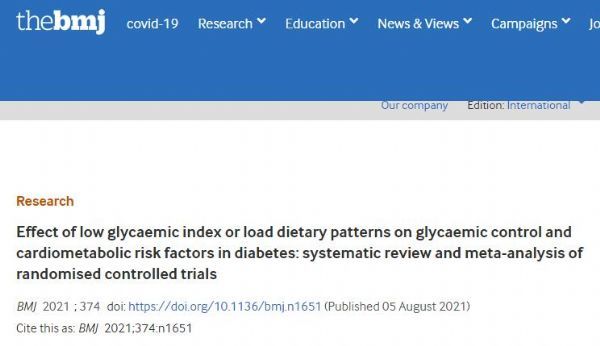BMJ: Low-glycemic diet may significantly improve the condition of diabetic
- Why Lecanemab’s Adoption Faces an Uphill Battle in US?
- Yogurt and High LDL Cholesterol: Can You Still Enjoy It?
- WHO Releases Global Influenza Vaccine Market Study in 2024
- HIV Infections Linked to Unlicensed Spa’s Vampire Facial Treatments
- A Single US$2.15-Million Injection to Block 90% of Cancer Cell Formation
- WIV: Prevention of New Disease X and Investigation of the Origin of COVID-19
BMJ: Low-glycemic diet may significantly improve the condition of diabetics
BMJ: Low-glycemic diet may significantly improve the condition of diabetics.
Glycemic index (GI, glycaemic index) is compared with reference foods (pure glucose or white bread), ranking foods according to the degree to which the body’s blood sugar level rises after intake of carbohydrate-containing foods;
According to the grade of glucose, GI≦55 is a low glycemic index food, 56-69 is a medium glycemic index food, and ≧70 is a high glycemic index food.
The glycaemic load of food (GL, glycaemic load) is the result of multiplying GI by the amount of carbohydrates available in a mistake (g) and dividing by 100.

Image source: https://www.bmj.com/content/374/bmj.n1651
Recently, a research report entitled “Effect of low glycaemic index or load dietary patterns on glycaemic control and cardiometabolic risk factors in diabetes: systematic review and meta-analysis of randomised controlled trials” was published in the international journal BMJ, Scientists from University of Toronto and other institutions have found through research that for diabetic patients, adherence to a low-glycemic diet may lead to small but important improvements in their blood sugar levels, cholesterol, weight and other risk factors.
The researchers said that these improvements are the results that can be observed outside of existing drugs or insulin therapy, which may indicate that low-glycemic diets may be used as additional therapies to help diabetic patients better achieve their effective management of the disease. Target.
The glycemic index can measure the speed at which different foods affect the body’s blood sugar levels. Research results show that low-GI foods such as vegetables, most fruits, beans, and whole grains may help diabetic patients maintain stable blood sugar levels and help reduce them Risk of heart disease.
Therefore, clinical guidelines around the world recommend that diabetic patients adopt a low GI or GL diet. However, the previous version of the European Association for the Study of Diabetes (EASD) guidelines was issued 15 years ago, and a number of clinical guidelines have been published since then. The results of the experiment.
Therefore, researchers set out to summarize the impact of low GI/GL diet patterns on blood glucose control and other known risk factors in diabetic patients, thereby helping to update the EASD nutritional treatment guidelines.
These findings are based on 27 randomized controlled trials published as of May 2021, which investigated the impact of low GI/GL diet patterns on patients for three weeks or more. These trials involved a total of 1617 patients with type 1 or type 2 diabetes, mainly middle-aged people, overweight or obese, and type 2 diabetes who received medication or insulin therapy and were moderately controlled.
The quality of these clinical trials varies, but researchers can use the worker’s GRADE system to assess the certainty of the evidence. The results of the study indicate that a lower GI/GL diet compared with a high GI/GL control diet is associated with a small but clinically significant decrease in blood glucose levels (HbA1c).
The level of other risk factors in the patient’s body has also decreased, including fasting blood glucose, LDL cholesterol, body weight and C-reactive protein, but blood insulin levels, HDL cholesterol, waist circumference or blood pressure have not decreased.

The figure shows the process of literature search and selection.
Image source: Laura Chiavaroli, et al. BMJ (2021). DOI:10.1136/bmj.n1651
The certainty of the evidence is very important for lowering blood glucose levels, but is moderate for most other results, which shows that the available evidence can well show that it may produce in this cohort study benefit. The researchers pointed out some limitations that may affect the results, such as the imprecision of the evidence of the effect of lower GI/GL diet on LDL cholesterol and waist circumference, and the small number of existing blood pressure and inflammatory marker trials. status quo.
However, the researchers said that the results of this article show that the low GI/GL diet is considered an acceptable safe diet strategy, which may be the main target of diabetes control (HbA1c), fasting blood glucose and other established heart Produces a small but meaningful reduction in metabolic risk factors, while surpassing the simultaneous use of hyperglycemic drugs or insulin therapy. In summary, this review article supports the existing low GI/GL diet used in diabetes management Suggestions for patterns.
(source:internet, reference only)
Disclaimer of medicaltrend.org
Important Note: The information provided is for informational purposes only and should not be considered as medical advice.



